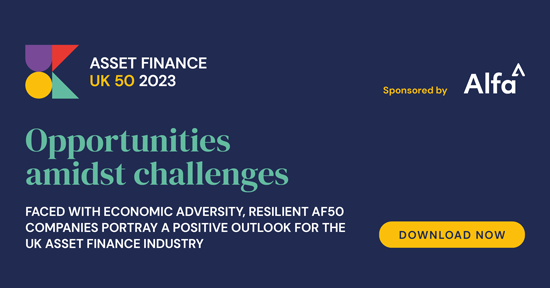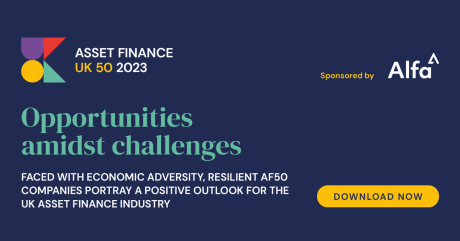Those who can remember studying economics at school, or anyone with a more recent interest in the subject, will be aware that markets can be classified as being in states of perfect competition (many sellers, one product), monopolistic competition (many sellers, different products), oligopoly (a few sellers), and monopoly (one seller).
Where does the UK asset finance industry fit on this scale? The Asset Finance 50 can provide the answer.
Competition experts measure a market using the Herfindahl index (HHI), which measures market concentration. The HHI is calculated by squaring the market share of each firm competing in the market and then summing the resulting numbers.
The HHI ranges between 0 (indicating perfect competition) and 10,000 (the market is run by a single monopolist). HHIs of more than 1,000 are generally considered to be concentrated, and those with HHIs of more than 2,000 to be highly concentrated.
Based on this year’s Asset Finance 50, the UK asset finance industry HHI is at 509 points, indicating an unconcentrated market that economic theory would suggest leads to plenty of competition, lower prices, and high quality. That compares to 540 points last year, hence the market has become even more competitive.
The low concentration fits with key changes we can see in this year’s Asset Finance 50 survey:
- Four firms – Haydock, Propel, Simply and United Trust – jumped up the AF50 by five steps in one year.
- Market leader Lombard’s market share continued to fall as it takes a more selective approach to targeting customers, this year down 1% to 15%.
- Five firms were added to the AF50 – Allica Bank, Cambridge and Counties Bank, InterBay, Praetura, and Rock Rail.
There’s also strong evidence from the Asset Finance 50 that the low concentration leads to strong competition not only in theory but also in practice.
Profit margins are modest with average profit before tax as a percentage of lending book at around 6% across all firms, and if we exclude the train rolling stock and car fleet specialists, only slightly above 3%. Both measures were up on the previous year, but of course that was in the the midst of the pandemic, so not the most useful comparison to make.
One practical consequence of this is that it makes any notion that firms do not offer ‘fair value’ under the new FCA consumer duty rules to be a little unrealistic! But for once, let’s not focus on regulation (after all, it probably accounts for less than 5% of the industry receivables).
Instead, we should consider cost of risk. Not many funders disclose their in-year write-offs, but the majority do show their year-end loan loss provisions. The average level this year was 1.3%, down from 1.7% last year. That may sound like good news, but we shouldn’t celebrate too much:
- The previous year provisions would have been made estimated during the peak period of Covid restrictions.
- Many of the losses associated with Arena are likely to have resulted in direct write-offs, so are not reflected in the provisions.
- There’s bound to be more to come from Arena in next year’s AF50, as further losses are realised for financial reporting purposes in 2022 year-ends.
- The UK cost of risk appears to be significantly higher than mainland Europe, where Leaseurope Index statistics show average provisions as a percentage of book in 2022 at just 0.2%.
This year I’ve been running a two-day training course for those (relatively) new to the asset finance industry. We note that the overall industry size has been pretty much constant in real terms for several decades, although within the totals there has been the fall in big-ticket leasing and corresponding increase in mainstream business. The trend in the Asset Finance 50 receivables, taken from the audited accounts, and shown in nominal terms in the report confirms this trend.
The course then moves to consider the future, and we show how the industry is changing, and why is it becoming such an exciting place to work. Here are just a few reasons to strap-in for some exciting times in the industry and further changes in the Asset Finance 50 survey results:
- As incentives to invest in more sustainable equipment as well as vehicles increase, SMEs as well as larger companies are likely to increase investment in more expensive assets and will need support from lessors (with the caveat that to offer this support, lessors will need to be able to record these leased assets as ‘green’ under the new sustainability reporting rules, the details of which are still being worked out).
- The Government’s plans to allow greater diversification in investment by UK institutional investors, particularly through investment in less liquid assets, could lead to more funds looking at investment opportunities in asset finance (with another caveat, this time being the availability of more transparent loan performance data at industry-level, to allow funds to understand the risks).
- Reflecting the above, and very much as already been seen in the United States, an increase in merger and acquisition activity within the industry, perhaps leading to a higher HHI concentration index more in line with other financial services and helping to achieve economies of scale.
- A lower and more sustainable cost of risk, as new industry-wide solutions to beat another Arena start to show their value.
Early indications are that next year’s Asset Finance 50 will report strong results for periods ending in 2023. Could this mark the start of a new stage in the industry’s development where we see significant growth in real terms and higher lease penetration rate? It’s looking more likely now than it has over the eight years the Asset Finance 50 has been running.
Download your copy of the AF50 UK Report 2023 by completing the form:






